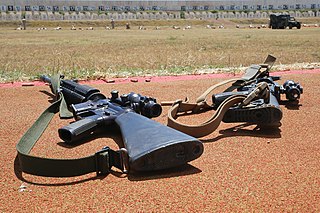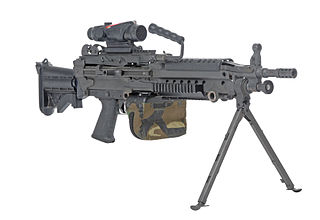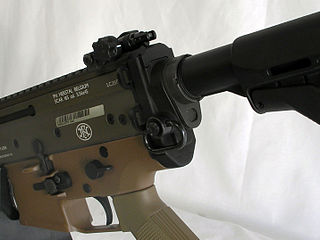
The Negev is a 5.56×45mm NATO light machine gun developed by the Israeli firearm manufacturer, Israel Weapon Industries (IWI).
The Steyr Scout is a modern scoped bolt-action rifle manufactured by Steyr Mannlicher and chambered primarily for 7.62 NATO, although other caliber options are offered commercially. It is intended to fill the role of a versatile, lightweight all-around rifle as specified in Jeff Cooper's scout rifle concept. Apart from the barrel and action, it is made primarily of polymers and is designed to be accurate to at least 300–400 meters. The Steyr Scout is also available in 5.56 NATO, .243 Winchester, 6.5 Creedmoor, .376 Steyr and 7mm-08 Remington.

The M240, officially the Machine Gun, Caliber 7.62 mm, M240, is the US military designation for the FN MAG a family of belt-fed, gas-operated medium machine guns that chamber the 7.62×51mm NATO cartridge.

The FN Minimi is a Belgian 5.56mm Squad Automatic Weapon, or SAW developed by Fabrique Nationale (FN) in Herstal by Ernest Vervier. First introduced in the late 1970s, it is now in service in more than 75 countries. The weapon is currently manufactured at the FN facility in Herstal and their U.S. subsidiary FN Manufacturing LLC.
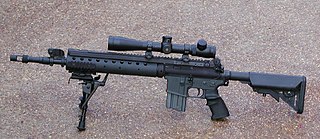
The United States Navy Mark 12 Mod 0/1 Special Purpose Rifle (SPR) is a semi-automatic rifle in service with United States Special Operations Forces used in the designated marksman role. SPR initially stood for Special Purpose Receiver, but that nomenclature has been replaced as the weapon became a stand-alone weapons system, and not just an add-on upper receiver assembly. The SPR was eventually type classified by the U.S. Navy as the Mk 12. Note that the weapon was developed by a Navy office for SOCOM units, not for use by units that fall under the conventional Navy.
The M40 rifle is a bolt-action sniper rifle used by the United States Marine Corps. It has had four variants—the M40, M40A1, M40A3, and M40A5. The M40 was introduced in 1966. The changeover to the A1 model was completed in the 1970s, the A3 in the 2000s, and the A5 in 2009.

The Squad Advanced Marksman Rifle (SAM-R) was a semi-automatic rifle developed by and in service with the United States Marine Corps. It gave Marines the capability to provide precision fire in support of the rifle squad, providing precision fire in support of an assault, and aid in observation and adjusting of supporting arms. The SAM-R was retired by the U.S. in the mid-2010s and thus is no longer in service, having been replaced by the M27 IAR.
The RPK is a 7.62×39mm light machine gun of Soviet design, developed by Mikhail Kalashnikov in the late 1950s, parallel with the AKM assault rifle. It was created as part of a program designed to standardize the small arms inventory of the Red Army, where it replaced the 7.62×39mm RPD light machine gun. The RPK continues to be used by the armed forces of countries of the former Soviet Union and certain African and Asian nations. The RPK is also manufactured in Bulgaria, Romania and Yugoslavia.
The Ruger 10/22 is a series of semi-automatic rifles produced by American firearm manufacturer Sturm, Ruger & Co., chambered for the .22 Long Rifle rimfire cartridge. It uses a patented 10-round rotary magazine, though higher capacity box magazines are also available. The standard Carbine version of the Ruger 10/22 has been in production continuously since 1964, making it one of the most successful rimfire rifle designs in history, with numerous third party manufacturers making parts and accessories for upgrading and customization. In fact, the 10/22's aftermarket is so prolific, that a 10/22 can be built with completely non-Ruger made components.

The Beretta Cx4 Storm is a pistol-caliber semi-automatic carbine aimed at the sporting, personal defense, and law enforcement markets. It is available in two models: one that accepts 92/96 magazines, and one that accepts Px4 series magazines, each available in 9×19mm Parabellum, .40 S&W, .45 ACP, and 9×21mm.

The HK33 is a 5.56mm assault rifle developed in the 1960s by West German armament manufacturer Heckler & Koch GmbH (H&K), primarily for export.

The Howa Type 89 Assault Rifle, referred to as the type 89 5.56mm rifle, is a Japanese assault rifle used by the Japan Self-Defense Forces, the Japan Coast Guard's Special Security Team units, and the Special Assault Team. It was never exported outside Japan due to its strict anti-hardware export policy. It is known in JGSDF service as Buddy.
The Sako TRG is a bolt-action sniper rifle line designed and manufactured by the Finnish firearms manufacturer, SAKO of Riihimäki. The TRG-21 and TRG-22 are designed to fire standard .308 Winchester /7.62×51mm NATO sized cartridges, while the TRG-41 and TRG-42 are designed to fire more powerful and dimensionally larger .300 Winchester Magnum (7.62×67mm) magnum and .338 Lapua Magnum (8.6×70mm) super magnum cartridges. They are available with olive drab green, desert tan/coyote brown, dark earth or black stocks, and are also available with a folding stock.
The CZ 452 is a series of magazine-fed bolt-action rimfire repeating rifles manufactured by the Czech firearms manufacturer Česká Zbrojovka Uherský Brod and imported into the United States by CZ-USA. Most versions of the 452 rifle series were discontinued in 2011 and replaced by the CZ 455, although CZ continues to offer the CZ 452 American in a left-hand model, with the bolt handle and ejection port located on the left side of the rifle.
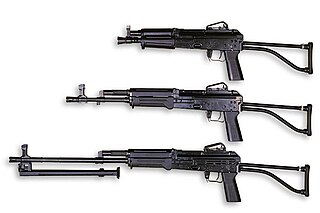
The ČZ 2000 is a prototype 5.56 mm caliber Czech weapon system, consisting of a standard rifle, carbine and light machine gun. The system was developed in 1991 after adapting the LADA firearm prototype J. Denel from the Brno-based Prototypa-ZM company is the chief designer for both systems. The ČZ 2000 was to be produced by Česká zbrojovka of Uherský Brod. It was to be the new service weapon of the Czech Army, replacing: the 7.62 mm vz. 58 assault rifle, 7.65 mm vz. 61 Škorpion submachine gun and 7.62 mm vz. 59 machine gun. As of 2007, the project has been discontinued.

The PKP Pecheneg is a Russian 7.62×54mmR general-purpose machine gun. It is a further development and modification of the PK machine gun. It is said to be more accurate than all its predecessors due to a heavier, non-removable, forced-air-cooling barrel with radial cooling ribs and a handle which eliminates the haze effect from hot gases and keeps the barrel cooler, making the weapon more reliable. Furthermore, the weapon is capable of having a telescopic sight or other sights mounted on it, increasing its accuracy and effective range.
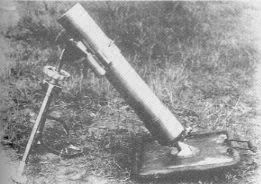
The Type 99 81 mm mortar was a Japanese mortar used primary by Imperial Japanese Army during World War II. The Type 99 designation was given to this gun as it was accepted in the year 2599 of the Japanese calendar (1939). The Type 99 81 mm mortar is typical of the Stokes-Brandt type mortar. The Type 99 81 mm mortar differs from the Type 97 81 mm infantry mortar in the shortness of its tube and in the method of firing. The differences between the Type 99 and the US 81-mm mortar, M1 are pronounced.

The UIT rail, also known as Anschutz rail, is a standard used for mounting slings and other gun accessories in competition shooting, and is essentially a T-slot track shaped aluminium extrusion profile accepting attachments in the form of T-slot nuts, or similar.

